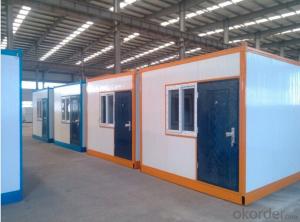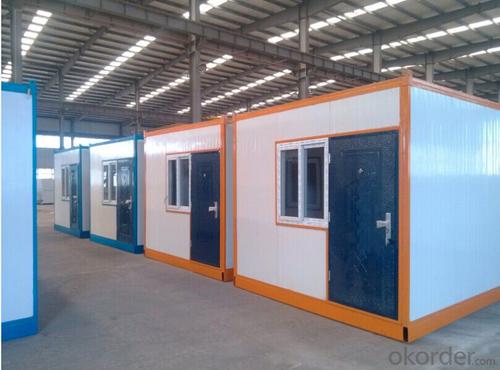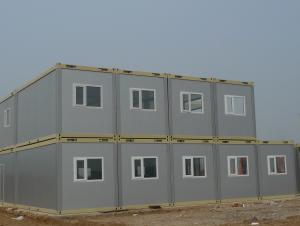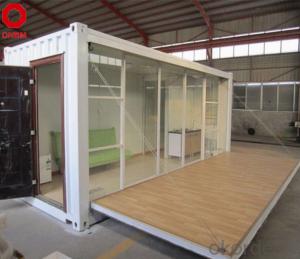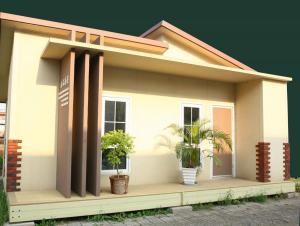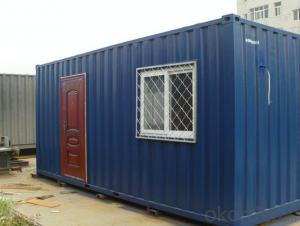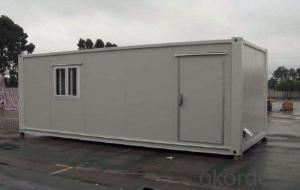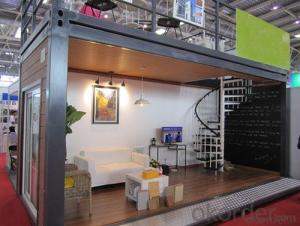China Manytimes usage Portable Container Washrooms
- Loading Port:
- Tianjin
- Payment Terms:
- TT OR LC
- Min Order Qty:
- 1 pc
- Supply Capability:
- 10000 pc/month
OKorder Service Pledge
OKorder Financial Service
You Might Also Like
China Manytimes usage Portable Container Washrooms
1.China integration activities chamber room
2.Product introduction
The assembled series slope roof prefabricated houses
"Constant" brand series of slope roof assembled prefabricated houses is the company launched a new concept of environmental protection building economical activities, ordinary, standard and luxury type 3 kinds.According to customer demand, in a standard module for space combination, formed the skeleton system USES light steel structure, and to sandwich panels and PU tile forming palisade and roofing system.Realize the simple and beautiful, the construction fast, use safety, the standard of general overlay idea, make the overlay houses into an industrialized production, inventory, for repeated use of stereotypes housing products.
Sex can
Reliable structure: light steel system of flexible structure, safe and reliable, satisfies the requirement of building structure design codes.
Tear open outfit is convenient: housing can be repeatedly disassembling, repeated use.The installation process need only simple tools.Average per person per day to install 20-30 square meters, 6 people a team, 2 days to complete 3 k standard prefabricated houses 1 x 10 k.
Beautiful decoration: housing overall beautiful, bright color, texture soft, board face level off, have good adornment effect.
Flexible layout: doors and Windows can be installed in any position, interior partition can be set in any horizontal axis.The stairs set outside.
The structure of the building structure waterproof, waterproof design, does not need to do any other waterproof processing.
Long service life, light steel structure anticorrosion coating processing, normal service life can reach more than 10 years.
Environmental conservation: the reasonable design, easy tear open outfit, can be used many times cycle, low attrition rate, do not produce construction waste, the average annual cost is much lower than other materials of similar houses.
Using standardized components, a variety of specifications: building length and width are to K (1 K = 1820 mm) for the module.Transverse dimensions of mk + 160, the longitudinal size of nk + 160.
With the way
Are widely used in road, railway, construction and other field operation of temporary housing construction;Urban municipal, commercial and other temporary housing, such as: temporary office, conference room, headquarters, dormitory and temporary stores, temporary schools, temporary hospitals, temporary parking area, temporary exhibition hall, temporary filling stations, etc.
3.Assemble series flat roof prefabricated houses
"Constant" assembled series flat roof prefabricated housing is through making full use of their own strength of sandwich wall panel and roof panel, after pulling, bolts, self-tapping screw connection and finalize the design activities of housing system.Can be industrialized production, use, interior decoration, realize the inside and outside is beautiful, fast, safe construction overlay concept, tight sealing, heat insulation, waterproof, fireproof, moistureproof.
Aesthetically pleasing: housing overall modelling beautiful, inside and outside are color decorative plates, good appearance, design and colour collocation to coordinate.
Long use period: normal service life can reach more than 10 years.Convenient transportation, dismantling recycling, environmental savings.
With the way
Are widely used in road, railway, construction and other field operation of temporary housing construction;Urban municipal, commercial and other temporary housing.Such as: temporary office, conference room, headquarters, dormitory and temporary stores, temporary schools, temporary hospitals, temporary parking area, temporary exhibition hall, temporary maintenance, temporary transformer room, temporary filling stations, etc.Other temporary housing areas, such as military logistics temporary occupancy, rescue and relief temporary occupancy, sterile laboratories, isolation rooms, communication substation room.Scenic area of temporary use leisure villa, vacation homes, etc.
Products > > activity control box, the bathroom
Box is by utilizing sandwich wall panel and roof panel connection of their own strength, by screw, bolts, self-tapping screw, wall sandwich plate and the steel structure base housing system composed of roof plate connection.Quick construction, whole movable, especially suitable for municipal facilities and field construction site of the gatehouse, service, etc.
Toilet is mainly is made of light steel structure, caigang sandwich board maintenance material, to give expulsion-typely wastewater and circulating water storage (microbes) drainage way portable toilet.Can be very convenient to install, move, move, especially suitable for streets, sports venues, the use of tourist attractions.
Fence is made of steel structure column, double color sandwich steel or single color pressed steel by bolt connection and into.All of its components are composed of standard parts, the arbitrary assembly, short installation period, the effect is good, the color can be specially made according to the requirements.Repeatable tear open outfit, use, construction waste, beautiful appearance.
- Q: Are container houses suitable for healthcare facilities?
- Yes, container houses can be suitable for healthcare facilities. They offer several advantages such as cost-effectiveness, quick construction time, and flexibility in design. Additionally, they can be easily modified and expanded to meet specific healthcare requirements. However, careful consideration should be given to factors like insulation, ventilation, and compliance with regulatory standards to ensure a safe and comfortable environment for patients and medical professionals.
- Q: Can container houses be designed to be aesthetically pleasing?
- Yes, container houses can definitely be designed to be aesthetically pleasing. With the right design approach and creativity, container houses can be transformed into beautiful and stylish homes. One way to achieve an aesthetically pleasing container house is through thoughtful exterior finishes. The exterior can be clad with various materials like wood, brick, or metal, which can give the house a more traditional or modern look. Adding windows, balconies, and other architectural elements can also enhance the overall design and make the house visually appealing. Inside, container houses can be designed to maximize space and create a comfortable living environment. Utilizing open floor plans, clever storage solutions, and strategic placement of windows and doors can make the interior feel spacious and inviting. Incorporating high-quality materials, finishes, and fixtures can add a touch of luxury and elegance to the house. Furthermore, landscaping and outdoor design can greatly contribute to the overall aesthetics of container houses. By creating a well-designed and maintained garden or patio area, container houses can seamlessly blend into their surroundings and create a harmonious and visually pleasing environment. Ultimately, the key to designing aesthetically pleasing container houses lies in the creativity and vision of the architects and designers involved. With the right design principles and attention to detail, container houses can surpass expectations and become stunning examples of innovative and beautiful architectural design.
- Q: What are the requirements for container house structure design?
- but also by space, materials and other objective conditions, in the container design should be fully considered Container module tool advantages and shortcomings
- Q: Are container houses suitable for artists or creative spaces?
- Container houses are an excellent choice for artists and those seeking creative spaces. These unconventional structures provide several advantages that cater to the needs of artists and creatives. To begin with, container houses are highly adaptable and can easily be converted into creative spaces. The sturdy construction of shipping containers allows for straightforward modifications, such as the addition of windows, doors, or skylights to bring in natural light. Artists can also design open and spacious interiors or divide the space to meet their specific requirements. The modular nature of containers even allows for the combination of multiple units to create larger spaces or unique configurations. Furthermore, container houses are cost-effective, making them a compelling option for artists. The materials used in building container houses are often more affordable than traditional building materials, making them accessible for artists with limited budgets. Additionally, the construction process of container houses is typically faster and more efficient, saving both time and money. Moreover, container houses are environmentally friendly, appealing to artists who prioritize sustainability. By repurposing shipping containers, their environmental impact is reduced, giving them a second chance at life. Artists can also incorporate eco-friendly features such as solar panels or rainwater harvesting systems into their container houses, further reducing their carbon footprint. Lastly, container houses offer a unique aesthetic that can inspire and stimulate creativity. The industrial and minimalist design of containers provides a blank canvas for artists to transform into their own creative haven. The unconventional nature of container houses can also serve as a source of inspiration, fueling artistic expression. In conclusion, container houses are highly suitable for artists and creative spaces. Their customizability, cost-effectiveness, eco-friendliness, and unique aesthetic all contribute to enhancing artistic pursuits and fostering creativity.
- Q: Are container houses suitable for sports facilities?
- Yes, container houses can be suitable for sports facilities. Container houses are versatile and customizable, allowing for easy modifications to accommodate specific sports requirements. They can be transformed into locker rooms, changing facilities, offices, or even small training spaces. Additionally, container houses are cost-effective and can be quickly assembled, making them an attractive option for temporary or mobile sports facilities.
- Q: Can container houses be designed with a wheelchair lift?
- Yes, container houses can definitely be designed with a wheelchair lift. In fact, the modular and customizable nature of container houses makes them highly adaptable to different accessibility needs. A wheelchair lift can be incorporated into the design of a container house to provide accessibility to individuals with mobility challenges. These lifts can be installed either externally or internally, depending on the specific requirements and preferences of the homeowner. By considering the dimensions and weight capacity of the wheelchair lift during the design phase, container houses can be made fully accessible and inclusive for people using wheelchairs.
- Q: How do container houses compare to traditional houses in terms of cost?
- Compared to traditional houses, container houses typically offer a greater cost-effectiveness. This is primarily due to the use of recycled shipping containers, which greatly reduces the necessary material and labor costs for construction. Additionally, container houses are known for their speedier construction process, further decreasing labor expenses. In contrast, the price of a traditional house can be considerably higher due to various factors, including the cost of land, extensive foundation work, and the need for multiple building materials. Conversely, container houses can be placed on different types of land, including small or irregularly shaped lots, potentially resulting in savings on land expenses. Furthermore, container houses are designed with energy-efficiency in mind, leading to long-term cost savings. With proper insulation and ventilation systems, heating and cooling expenses are reduced, making container houses more financially manageable to maintain. Nevertheless, it is important to acknowledge that the overall cost of a container house may differ based on factors like customization, location, and desired level of finishings and amenities. While container houses generally provide cost advantages, it is crucial to conduct thorough research and planning to accurately compare costs with traditional houses, taking all necessary considerations into account.
- Q: How durable are container houses?
- Container houses are known for their durability and strength. These structures are typically made from corten steel, which is highly resilient and resistant to corrosion. Corten steel is designed to withstand extreme weather conditions, making it suitable for container housing. Container houses are also built to withstand transportation and stacking. They are designed to be stackable up to nine containers high, which demonstrates their ability to handle significant weight and pressure. Furthermore, container houses are built to last for a long time. With proper maintenance and care, these structures can have a lifespan of 25 to 30 years or even more. The steel frames are resistant to pests, mold, and fire, further enhancing their durability. In terms of structural integrity, container houses can withstand strong winds and even earthquakes. Their solid steel structure provides stability and strength, ensuring the safety of occupants. However, it is important to note that the durability of container houses can vary depending on the construction methods used and the quality of materials. Proper insulation, sealing, and regular maintenance are essential to ensure longevity and prevent any potential issues. In summary, container houses are highly durable structures. With their robust steel frames and resistance to various environmental factors, these houses can withstand the test of time and provide a safe and secure living space for their occupants.
- Q: Are container houses easy to transport during the construction process?
- Yes, container houses are relatively easy to transport during the construction process. Due to their modular and portable nature, containers can be easily transported by trucks or shipping vessels to the desired location. This eliminates the need for extensive on-site construction, making the process more efficient and cost-effective.
- Q: Can container houses be designed with a balcony or deck?
- Yes, container houses can definitely be designed with a balcony or deck. In fact, many architects and designers have found creative ways to incorporate outdoor spaces into container house designs. Balconies and decks can be added to container houses by extending the structure with additional containers or by constructing a steel frame that supports the outdoor space. These outdoor areas provide the perfect opportunity to enjoy the surrounding views, entertain guests, or simply relax outside. Additionally, the use of balconies and decks in container house designs adds an aesthetic appeal and enhances the overall functionality of the space.
Send your message to us
China Manytimes usage Portable Container Washrooms
- Loading Port:
- Tianjin
- Payment Terms:
- TT OR LC
- Min Order Qty:
- 1 pc
- Supply Capability:
- 10000 pc/month
OKorder Service Pledge
OKorder Financial Service
Similar products
Hot products
Hot Searches
Related keywords
